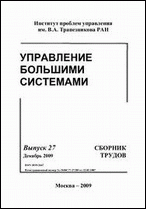|
Control in Social and Economic Systems
Differentiation of inequality dynamics in different types of regions
N. A. Roslyakova, N. N. Trenev
V.A. Trapeznikov Institute of Control Sciences of RAS, Moscow
Abstract:
The aggravation of crisis phenomena around the world raises issues of social inequality extremely acutely. As the main theoretical construction, the authors used the hypothesis of S. Kuznets that inequality changes over time and is consistent with the processes of economic growth. To date, the literature has received many confirmations of the Kuznets hypothesis and justifications for other types of connection between economic growth and inequality. In this work, five model regions of Russia (Ulyanovsk Region; St. Petersburg; Karachay-Cherkess Republic; Magadan Region; Voronezh Region) acted as objects of research. Based on data from 1998-2020, using regression modeling, the classical specification of the Kuznets curve was evaluated. The hypothesis was not confirmed for St. Petersburg, the Karachay-Cherkess Republic and the Magadan region. There is a reverse situation, when a certain level of the economy is reached, the growth of inequality accelerates. At the same time, real data indicate that only St. Petersburg is in a state of economic growth with a decrease in inequality. For the Ulyanovsk and Voronezh regions, the Kuznets hypothesis was confirmed. The results obtained confirm the initial hypothesis about a high level of differentiation of regions both in terms of inequality parameters and in terms of the main mechanisms of interaction between economic growth and inequality.
Keywords:
Kuznets curve, regions of Russia, inequality, economic growth, regression analysis.
Received: September 16, 2022
Published: November 30, 2022
Citation:
N. A. Roslyakova, N. N. Trenev, “Differentiation of inequality dynamics in different types of regions”, UBS, 100 (2022), 152–173
Linking options:
https://www.mathnet.ru/eng/ubs1129 https://www.mathnet.ru/eng/ubs/v100/p152
|

| Statistics & downloads: |
| Abstract page: | 42 | | Full-text PDF : | 7 | | References: | 20 |
|




 Contact us:
Contact us: Terms of Use
Terms of Use
 Registration to the website
Registration to the website Logotypes
Logotypes








 Citation in format
Citation in format 